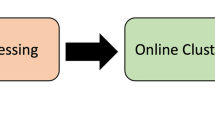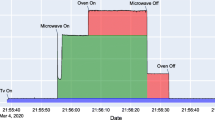Abstract
The aim of non-intrusive appliance load monitoring (NIALM) is to disaggregate the energy consumption of individual electrical appliances from total power consumption utilizing non-intrusive methods. In this paper, a systematic approach to ON-OFF event detection and clustering analysis for NIALM were presented. From the aggregate power consumption data set, the data are passed through median filtering to reduce noise and prepared for the event detection algorithm. The event detection algorithm is to determine the switching of ON and OFF status of electrical appliances. The goodness-of-fit (GOF) methodology is the event detection algorithm implemented. After event detection, the events detected were paired into ON-OFF pairing appliances. The results from the ON-OFF pairing algorithm were further clustered in groups utilizing the K-means clustering analysis. The K-means clustering were implemented as an unsupervised learning methodology for the clustering analysis. The novelty of this paper is the determination of the time duration an electrical appliance is turned ON through combination of event detection, ON-OFF pairing and K-means clustering. The results of the algorithm implementation were discussed and ideas on future work were also proposed.
Similar content being viewed by others
References
Hart G W. Nonintrusive appliance load monitoring. Proceedings of the IEEE, 1992, 80(12): 1870–1891
Yang C C, Soh C S, Yap V V. Comparative study of event detection methods for non-intrusive appliance load monitoring. Energy Procedia, 2014, 61, 1840–1843
Zeifman M, Roth K. Nonintrusive appliance load monitoring: review and outlook. IEEE Transactions on Consumer Electronics, 2011, 57(1): 76–84
Zoha A, Gluhak A, Imran M A, Rajasegarar S. Non-intrusive load monitoring approaches for disaggregated energy sensing: a survey. Sensors (Basel), 2012, 12(12): 16838–16866
Wong Y F, Sekercioglu Y A, Drummond T, Wong V S. Recent approaches to non-intrusive load monitoring techniques in residential settings. In: IEEE Symposium on Computational Intelligence Applications in Smart Grid. Singapore, 2013, 73–79
Norford L K, Leeb S B. Non-intrusive electrical load monitoring in commercial buildings based on steady-state and transient load-detection algorithms. Energy and Building, 1996, 24(1): 51–64
Laughman C, Lee K, Cox R, Shaw S, Leeb S, Norford L, Armstrong P. Power signature analysis. IEEE Power and Energy Magazine, 2003, 1(2): 56–63
Liang J, Ng S K K, Kendall G, Cheng JWM. Ng S K K, Kendall G, Cheng J W M. Load signature study Part I: basic concept, structure, and methodology. IEEE Transactions on Power Delivery, 2010, 25(2): 551–560
Lee W K, Fung G S K, Lam H Y, Chan F H Y, Lucente M. Exploration on load signatures. In Proceedings of International Conference on Electrical Engineering (ICEE), Sapporo, Japan, 2004, 1–5
Lam H Y, Fung G S K, Lee W K. A novel method to construct taxonomy electrical appliances based on load signatures. IEEE Transactions on Consumer Electronics, 2007, 53(2): 653–660
Patel S N, Robertson T, Kientz J A, Reynolds M S, Abowd G D. At the flick of a switch: detecting and classifying unique electrical events on the residential power line. In: Proceedings of the 9th International Conference on Ubiquitous Computing. Innsbruck, Austria, 2007, 271–288
Gupta S, Reynolds M S, Patel S N. ElectriSense: single-point sensing using EMI for electrical event detection and classification in the home. In: Proceedings of the 12th ACM International Conference on Ubiquitous Computing. Copenhagen, Denmark, 2010, 139–148
Leeb S B, Shaw S R, Kirtley J L. Transient event detection in spectral envelope estimates for nonintrusive load monitoring. IEEE Transactions on Power Delivery, 1995, 10(3): 1200–1210
Chang H H, Yang H T, Lin C L. Load identification in neural networks for a non-intrusive monitoring of industrial electrical loads. Lecture Notes in Computer Science, 2008, 5236: 664–674
Figueiredo MB, Almeida A D, Ribeiro B. An experimental study on electrical signature identification of non-intrusive load monitoring (NILM) systems. Lecture Notes in Computer Science, 2011, 6594: 31–40
Chang H H. Non-intrusive demand monitoring and load identification for energy management systems based on transient feature analyses. Energies, 2012, 5(12): 4569–4589
Shaw S R, Leeb S B, Norford L K, Cox R W. Nonintrusive load monitoring and diagnostics in power systems. IEEE Transactions on Instrumentation and Measurement, 2008, 57(7): 1445–1454
Hazas M, Friday A, Scott J. Look back before leaping forward: four decades of domestic energy inquiry. IEEE Pervasive Computing, 2011, 10(1): 13–19
Anderson K, Berges M, Ocneanu A, Benitez D, Moura J MF. Event detection for non-intrusive load monitoring. In: Proceedings of the 38th Annual Conference on IEEE Industrial Electronics Society (IECON). Montreal, Canada, 2012, 3312–3317
Zico Kolter J, Johnson M J. REDD: a public data set for energy disaggregation research. In: Proceedings of the SustKDD Workshop on Data Mining Applications in Sustainability. San Diego, USA, 2011, 1–6
Arias-Castro E, Donoho D L. Does median filtering truly preserve edges better than linear filtering? Annals of Statistics, 2009, 37(3): 1172–1206
Giri S, Lai P, Berges M. Novel techniques for ON and OFF states detection of appliances for power estimation in non-intrusive load monitoring. In: Proceedings of the 30th International Symposium on Automation and Robotics in Construction and Mining (ISARC). Montreal, Canada, 2013, 522–530
Jin Y, Tebekaemi E, Berges M, Soibelman L. Robust adaptive event detection in non-intrusive load monitoring for energy aware smart facilities. In: Proceedings of the 2011 International Conference on Acoustics, Speech and Signal Processing (ICASSP’11). Prague, Czech Republic, 2011, 4340–4343
U.S. Department of Energy. Estimating Appliances and Home Electronic Energy Use. 2014-11-05, http://energy.gov/energysaver/articles/estimating-appliance-and-home-electronic-energy-use
Goncalves H, Ocneanu A, Berges M. Unsupervised disaggregation of appliances using aggregated consumption data. In: Proceedings of the SustKDD Workshop on Data Mining Applications in Sustainability, San Diego, USA, 2011, 1–6
Wang Z, Zheng G. Residential appliances identification and monitoring by a nonintrusive method. IEEE Transactions on Smart Grid, 2012, 3: 80–92
Author information
Authors and Affiliations
Corresponding author
Rights and permissions
About this article
Cite this article
Yang, C.C., Soh, C.S. & Yap, V.V. A systematic approach to ON-OFF event detection and clustering analysis of non-intrusive appliance load monitoring. Front. Energy 9, 231–237 (2015). https://doi.org/10.1007/s11708-015-0358-6
Received:
Accepted:
Published:
Issue Date:
DOI: https://doi.org/10.1007/s11708-015-0358-6




